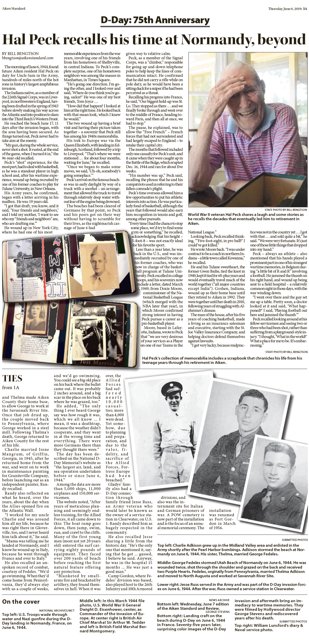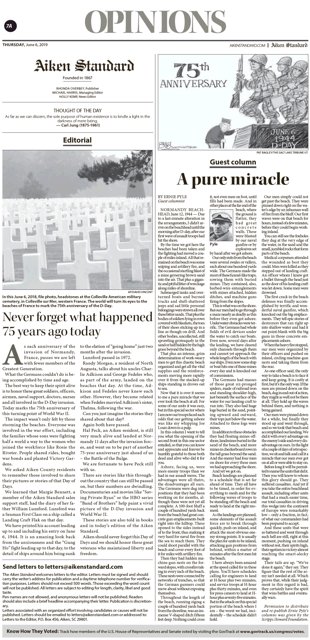Before history disappears
How the Aiken Standard remembered D-Day
"This morning about 0500 the convoy realized its destination and the first wave was formed and started for the beach. Our job was to sweep for floating mines and air protection. When we were about 1800 yards from the beach we threw our mine sweeping gear over and that is where the fun started. They begin to fire at us from the shore as we went in LCF 31 on our port side was hit and went down. And on our starboard side I saw P.C. 1261 going down. After we saw this we were all so damn scared. We wish we had never seen that many but we had to keep going.
"After the first troops and rockets hit the beach things begin to quiet down. All day and night troops were sent to the beach."
P.C. 1621 was the first ship sunk on D-Day, June 6, 1944.
William Lunsford was a Navy Gunfire Support Craft specialist on USS LCF-27 (or Landing Craft Flak), part of the invasion force at Utah Beach in Normandy. Lunsford is the father of Margie Bennett, a sales support employee at the Aiken Standard in South Carolina. He kept a diary, and excerpts from it made up part of a package of stories commemorating the 75th anniversary of D-Day last week.
"They're all in their 90s now," said Managing Editor Michael Harris. "Time is killing them more than the Germans did, as I pointed out in the editorial. We're losing them. So I wanted to go into it with something different."
The Standard asked readers for their memories, stories, photos and other contributions, knowing that the dwindling number of World War II veterans meant that direct interviews would be limited. The plan was flexible based on what was submitted.
It was during an early general conversation about the project that Bennett said her father had kept a diary. The only journal remaining turned out to be the one containing D-Day entries, and Harris transcribed it for use in the newspaper.
Another story was submitted by an Aiken resident who searched in Normandy for the grave of a relative of family friends in Ohio. The man gives talks on the history of the period accompanied by maps and photographs that were also published in the newspaper. He found the soldier's grave in a U.S. cemetery near Omaha Beach.
The paper did locate a local veteran who landed in Normandy 11 days after D-Day and could be interviewed. And on the Friday before publication, Harris talked with an Aiken man whose uncle's sisters had met a soldier in training who was stationed at Fort Gordon in Georgia. That soldier fell in love with and married one of the sisters. Both the soldier and the uncle ended up at Utah Beach on D-Day.
One of the sisters was the only person of the four still living, and Harris quickly sent out a reporter to get that story to add to the package.
Other pieces included an editorial, a roundup of readers' memories and a photo collage with a reproduction of the June 7, 1944 edition of the Aiken Standard.
Harris said the next history project will be the 50th anniversary of the moon landing in July. A local state representative and his wife had their first date watching the event, Harris said.
Later in the summer, he plans a personal column tied to the 25th anniversary of a number of unusual happenings in 1994. Events that year included the Olympic figure skating scandal between Tonya Harding and Nancy Kerrigan, the professional baseball strike that wiped out the World Series and the O.J. Simpson case. The enduring image, he thinks, is the slow-speed police chase of the white Bronco in which Simpson was riding.
 |
|
Jane Nicholes |
Jane Nicholes is a regular contributor to the Southern Newspaper Publishers Association's eBulletin and is a freelance writer and editor based in coastal Alabama. She is an award-winning veteran of more than 30 years in the newspaper business. Reach her at jbnicholes@att.net.













